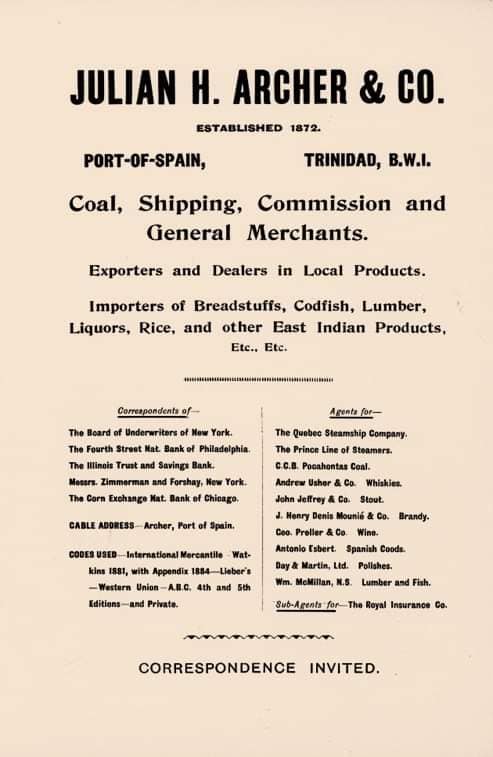|
The heap of coal on South Quay around 1910 A 1904 advertisement for the Archer business concerns Author : Angelo Bissessarsingh.
Port-of-Spain has one of the finest natural harbours in the world. Being almost completely landlocked, it is not susceptible to swells or powerful currents which would make for a dangerous anchorage. Its only failing is that the water was not deep enough for ships to draw alongside the quay, a dilemma which was not remedied until the construction of a deep water harbor in 1931. Nevertheless, the port was a busy place for ships calling from all parts of the world, and coaling was a major economic activity. With the coming of steamships in the 1820s, sailing vessels took a back seat although were not entirely obsolete. Some steamships even boasted masts and sails in case the boilers burst (a not uncommon occurrence due to poor metal castings). Trinidad was a great port of call for many large shipping lines including the Royal Mail Steamship Packet Company and the White Star Line, owners of the infamous Titanic. Local firms like Geo. F. Huggins and Trinidad Shipping and Trading Company also possessed their own steamships. With so many steamers around, an indispensable necessity was coal, and large quantities thereof. Lignite, a low-grade coal, occurs in Trinidad (Sangre Grande, Irois, Savonetta) and was identified in 1860 by geologists Wall and Sawkins. These lignite deposits, although substantial were never exploited commercially due to the low price of the commodity and high production costs. Manjack, a brittle form of graphite-matrix bitumen was mined profitably at Vistabella and Williamsville in south Trinidad from the 1890s to the 1920s. Despite these local sources, the bulk of the coal used in the colony was imported from England and the United States. Aside from use in steamships, coal was also indispensable for the railways of the island. The first local steam locomotive, the Forerunner, traversed the rails of the Cipero Tramroad between Princes Town and San Fernando as early as 1864. The Trinidad Government Railway began operations in 1876 and also needed coal since oil-fuelled locomotives would not appear until the 1920s. Added to this, large sugar manufacturing concerns had their own private railways leading to central factories at Orange Grove, Usine Ste. Madeline, Reform, Brechin Castle, Woodford Lodge and Forres Park. The English-creole Archer family,and its patriarch, speculator Julian H. Archer had been movers and shakers in the local economy for many years , being founders of the Trinidad Building and Loan Association and the Trinidad Fire Insurance Co. Established in 1872, the company did good business in the booming Trinidad economy which was riding the tide of high cocoa prices and a spike in production. William Stedman Archer, a son of Julian , diversified the family holdings to cater for the ever increasing need for coal. Although there were other importers of the fuel Archer’s Coal Depot soon seized the lion’s share of the market. This was so for several reasons. Firstly, Archer’s had a regular supply of the best quality coal, being a subsidiary of sorts of the Berwind White Coal Company which had its own mines in Pennsylvania, supplying a bituminous , high grade of coal which did not produce as much residue and smog as lower grade stuff. Originally stockpiled in the open air the fuel was eventually stored in a massive warehouse, since storing coal exposed to the weather reduced its combustibility. Secondly, the firm owned a fleet of tugs and barges which catered for the fact that larger ships could not dock alongside the St. Vincent St. Jetty, so Archer’s took the coal out to these clients. The business’s office was on Broadway and its warehouse at South Quay. The company was managed from 1912 by A. Cory Davies, an Englishman who had come out to the colony as a clerk in the Colonial Bank in 1895. The advent of the oil age in 1912 posed a not inconsiderable threat to the coal business, although wholesale displacement of steam engines by diesel engines was still at least three decades away. In 1913-14, Trinidad Leaseholds Ltd. began oil production at Barrackpore near Penal, and Forest Reserve near Fyzabad, with the crude being pumped to its refinery at Pointe-a-Pierre for conversion into gasoline. Regent Petrol, the brand produced by T.L.L was also sold by Archer’s who secured the distributorship for P.O.S where the motor car was becoming a popular sight on the road. The petrol was sold in large drums to motorists since there were no gas stations until around 1918. Archer’s coal depot was in business well into the 1930s until it closed for good. (Source: Virtual Museum of Trinidad and Tobago)
0 Comments
Leave a Reply. |
T&T news blogThe intent of this blog is to bring some news from home and other fun items. If you enjoy what you read, please leave us a comment.. Archives
May 2025
Categories
All
|



 RSS Feed
RSS Feed